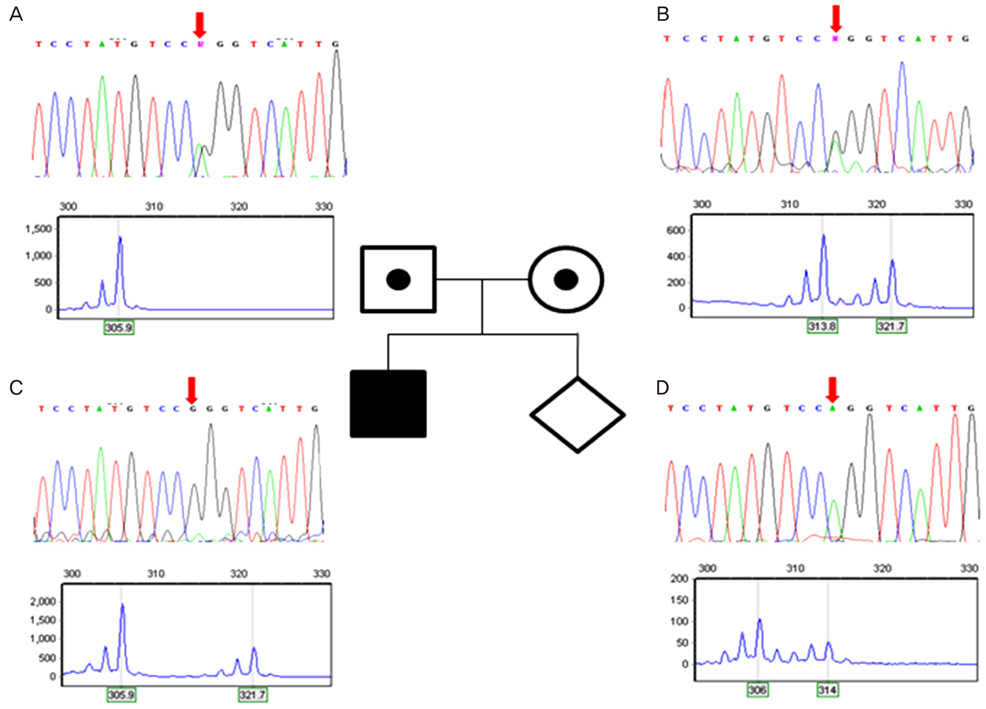Obstet Gynecol Sci.
2014 May;57(3):244-247. 10.5468/ogs.2014.57.3.244.
The first successful live birth following preimplantation genetic diagnosis using PCR for type 1 citrullinemia
- Affiliations
-
- 1Division of Reproductive Endocrinology and Infertility, Department of Obstetrics and Gynecology, University of Ulsan College of Medicine, Asan Medical Center, Seoul, Korea. chnkim@amc.seoul.kr
- 2Medical Genetic Center, University of Ulsan College of Medicine, Asan Medical Center, Seoul, Korea.
- KMID: 1704434
- DOI: http://doi.org/10.5468/ogs.2014.57.3.244
Abstract
- Type 1 citrullinemia (CTLN1) is an autosomal recessive inherited metabolic disorder caused by anargininosuccinicnate synthetase deficiency. The patient was a 38-year-old Korean woman who is a carrier for CTLN1 and her first baby was diagnosed with CTLN1. Preimplantation genetic diagnosis (PGD) for CTLN1 in day 3 embryos using polymerase chain reaction was performed for live birth of healthy baby who is no affected with CTLN1. One unaffected blastocyst was transferred. This resulted in a clinical pregnancy and the live birth of healthy male twin. They were confirmed to be unaffected with CTNL1 by post natal diagnosis. This is the first case report of the use of PGD for CTNL1.
Keyword
MeSH Terms
Figure
Reference
-
1. Engel K, Hohne W, Haberle J. Mutations and polymorphisms in the human argininosuccinate synthetase (ASS1) gene. Hum Mutat. 2009; 30:300–307.2. Haberle J, Pauli S, Linnebank M, Kleijer WJ, Bakker HD, Wanders RJ, et al. Structure of the human argininosuccinate synthetase gene and an improved system for molecular diagnostics in patients with classical and mild citrullinemia. Hum Genet. 2002; 110:327–333.3. Maestri NE, Clissold DB, Brusilow SW. Long-term survival of patients with argininosuccinate synthetase deficiency. J Pediatr. 1995; 127:929–935.4. Brusilow SW, Maestri NE. Urea cycle disorders: diagnosis, pathophysiology, and therapy. Adv Pediatr. 1996; 43:127–170.5. Singh RH. Nutritional management of patients with urea cycle disorders. J Inherit Metab Dis. 2007; 30:880–887.6. Brunetti-Pierri N, Lamance KM, Lewis RA, Craigen WJ. 30-year follow-up of a patient with classic citrullinemia. Mol Genet Metab. 2012; 106:248–250.7. No. 11441, Article 14-1. Mother and Child Health Law. 2012. 05. 23.8. Batshaw ML, MacArthur RB, Tuchman M. Alternative pathway therapy for urea cycle disorders: twenty years later. J Pediatr. 2001; 138:1 Suppl. S46–S54.9. Handyside AH, Kontogianni EH, Hardy K, Winston RM. Pregnancies from biopsied human preimplantation embryos sexed by Y-specific DNA amplification. Nature. 1990; 344:768–770.10. Harper JC, Sengupta SB. Preimplantation genetic diagnosis: state of the art 2011. Hum Genet. 2012; 131:175–186.11. Harper JC, Wilton L, Traeger-Synodinos J, Goossens V, Moutou C, SenGupta SB, et al. The ESHRE PGD Consortium: 10 years of data collection. Hum Reprod Update. 2012; 18:234–247.12. Sermon K, Van Steirteghem A, Liebaers I. Preimplantation genetic diagnosis. Lancet. 2004; 363:1633–1641.13. Simpson JL. Preimplantation genetic diagnosis at 20 years. Prenat Diagn. 2010; 30:682–695.
- Full Text Links
- Actions
-
Cited
- CITED
-
- Close
- Share
- Similar articles
-
- Successful birth with preimplantation genetic diagnosis using single-cell allele-specific PCR and sequencing in a woman with hypochondroplasia due to FGFR3 mutation (c.1620C>A, p.N540K)
- Preimplantation genetic testing for aneuploidy: The management of mosaic embryos
- Recent Trends in Preimplantation Genetic Diagnosis (PGD)
- Reliability of the Single Cell PCR analysis for Preimplantation Genetic Diagnosis of Single Gene Disorders
- Application of Hot Start PCR Method in PCR-based Preimplantation Genetic Diagnosis


